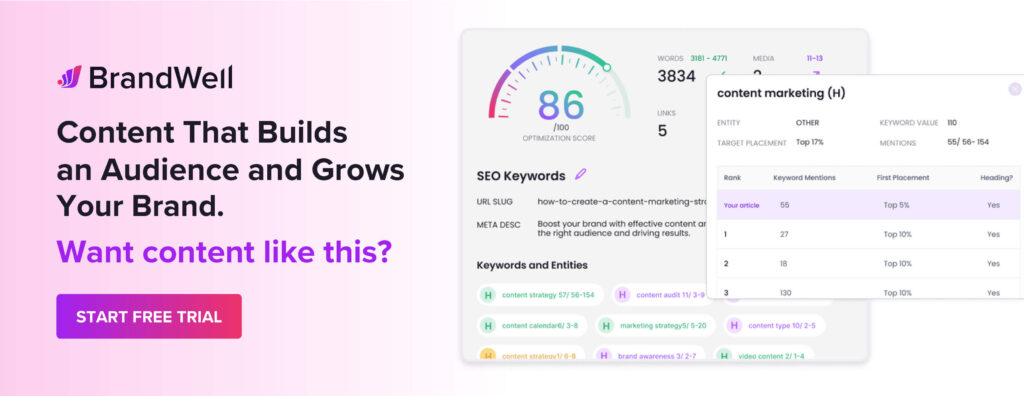Discover top guides, trends, tips and expertise from AIO Writers
Best Content Strategy for Your Brand + Examples of Successful Campaigns
Julia McCoy
Friday, 9th Jun 2023
Picture this:
You’ve mastered the art of creating compelling content, but your website’s traffic remains stagnant.
The culprit? A lack of a well-crafted content marketing strategy.
Research from the Content Marketing Institute revealed that only 40% of B2B marketers have a documented content marketing strategy. 33% have some sort of strategy and 27% have no strategy at all.
Meanwhile, 50% of marketers simply outsource their content marketing activities.
In recent years, capturing audiences’ attention has become increasingly difficult, making having an SEO content strategy even more crucial to your business. A well-crafted plan can help drive organic traffic, increase brand visibility, and ultimately convert visitors into loyal customers.
However, among the marketing agencies that follow a content marketing strategy, only 11% think they have a good one.
So, how do you build an effective content marketing strategy?
In this blog post, we’ll look at the key steps of building your content marketing strategy that’s in line with your business objectives. From identifying your target audience to researching keywords and creating quality content, our comprehensive guide has got you covered.
By following our strategic approach, you’ll be able to engage potential customers more effectively while ranking higher on SERPs – ultimately boosting your online presence and driving business growth.
What is a Content Marketing Strategy?
A content marketing strategy is a plan for creating and distributing valuable, relevant content to attract and retain a target audience.
The plan involves figuring out who you want to reach, what they care about, and giving them exactly what they need.
To do this, you create content — blog posts, ebooks, videos, podcasts, infographics, or whatever people like — and you share it through various channels online.
The goal of your content marketing strategy is to make you a trusted expert in your field, so people think of you first when they need help.
How to Create a Winning Content Marketing Strategy in 9 Steps
Developing a successful content marketing strategy is imperative for any business looking to improve its online presence and drive more organic traffic.
To create an effective plan, you need to follow several key steps:
Step 1: Define Your Content Goals
A strong content marketing strategy must start with a clear purpose. Before jumping into creation, it’s wise to take some time to set goals.
It’s kind of like knowing where to shoot an arrow before releasing it. If you just fire it into the air with no target, what are the chances of hitting anything? Your content goals should align with your overall business objectives.
Some examples of smart goals include boosting brand recognition, reaching more customers, pulling in new leads, or increasing sales.
It’s perfectly OK to have a combination of multiple goals. This clarity acts as a guide in determining the most fitting content type and promotion methods.
Define what you aim to achieve to build a content marketing strategy that’s in perfect harmony with your wider business aspirations.
Step 2: Identify Your Target Audience
The next crucial aspect of creating an efficient content marketing strategy is getting up close and personal with your potential customers.
Imagine you’re chatting with someone – if they speak French and you speak Spanish, how would you effectively communicate? You wouldn’t get far, right?
It’s critical to know who your audience is – their desires, struggles, passions, the language they use – and where they hang out online. If you know this, you’ll craft captivating, tailor-made content that catches their interest.
Understanding their pain points, aspirations, and preferred content formats will enable you to create content that resonates deeply with them, increasing the likelihood of engagement, lead generation, and conversions. This involves conducting thorough market research, analyzing your existing customer base, and utilizing social listening tools to gather insights into their online behavior.
Consider creating what marketing pros call ‘buyer personas’ as this will help bring your audience into focus.
For example, if your product targets busy moms trying to balance family life and work, their interests will include productivity hacks, quick and healthy meal ideas, time-saving tips, and so on. By speaking their language, you’ll see engagement jump like you wouldn’t believe.
To effectively engage with your readers, you must first determine their characteristics and wants.
Demographics
Begin by gathering data on the age range, gender distribution, income levels, educational background, and geographic location of your ideal customers. You can use tools like Google Analytics, social media insights, or customer surveys to gather this information.
Interests and Pain Points
To better understand the interests of your target audience and address their concerns effectively through content creation, participate in forums such as Reddit, Quora, social media groups, or comment sections on industry-related blogs for common questions or problems they face.
Online Behavior Patterns
Studying the behavior patterns of your audience when they’re online can help guide you in building your SEO content marketing strategy.
- Browsing habits: Which websites or platforms are your target audience frequently visiting? This can provide you with valuable insights on where you should focus your promotional efforts.
- Social media usage: Determine which social networks are most popular among your desired demographic so you can create shareable content specifically for these platforms.
- User-generated reviews: Monitor review sites like Yelp or TrustPilot to gauge consumer sentiment towards products/services similar to yours.
Taking these factors into account will help shape a more targeted SEO content marketing strategy that appeals directly to those who matter most – prospective clients seeking solutions from businesses just like yours.
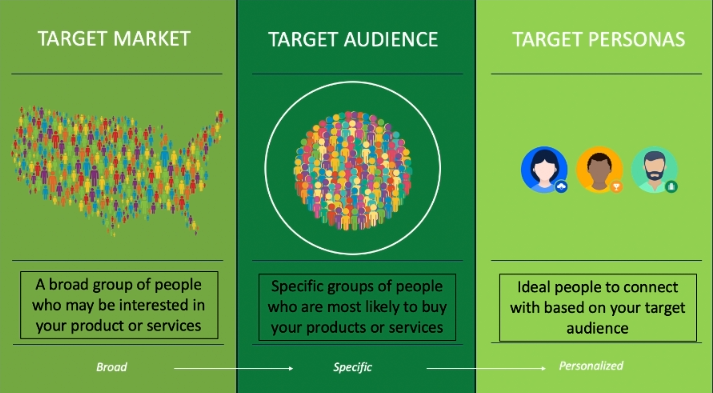
Screenshot from Search Engine Journal
Step 3: Analyze Your Competitors’ Content
To stay ahead in the game, it is crucial to analyze your competitors’ strategies. Identify their strengths and weaknesses by examining their keyword usage, backlink profiles, social media presence, and overall site structure. This information will help you determine where you can outperform them or fill gaps they may have missed.
Step 4: Do a Content Audit (If Needed)
Consider doing a content audit if you already have articles or videos on your site or YouTube channel.
The main aim of a content audit is to identify what’s working and what could work better, and pinpoint those content gaps needing to be addressed.
This involves analyzing metrics such as page views, bounce rate, time on page, and conversions to determine the strengths and weaknesses of your existing content.
By analyzing these data points, you’re able to discern patterns that contribute to higher performance — be it topics, formats, or distribution channels.
Step 5: Plan Your Content Topics
Implementing a successful content marketing strategy without consistent content output is almost impossible. An easy fix is establishing an editorial calendar. This simple step creates a clear blueprint of what type of content to produce, which channels to focus your content marketing efforts on, and a timeline for posting so that you never find yourself in the ‘I have nothing to post today’ crunch.
Based on your understanding of your target audience, create a list of content topics that align with their needs. Aim for a mix of informational, educational, and promotional content.
A well-organized content calendar will help you stay organized, maintain consistency, and ensure that you are regularly providing valuable content to your audience. There are many tools available, both free and paid, that can help you create and manage your content calendar effectively.
One such tool is BrandWell, a powerful brand growth platform that integrates a content calendar into its long-form content writer so you can assign projects and keep track of deadlines — without buying another software.
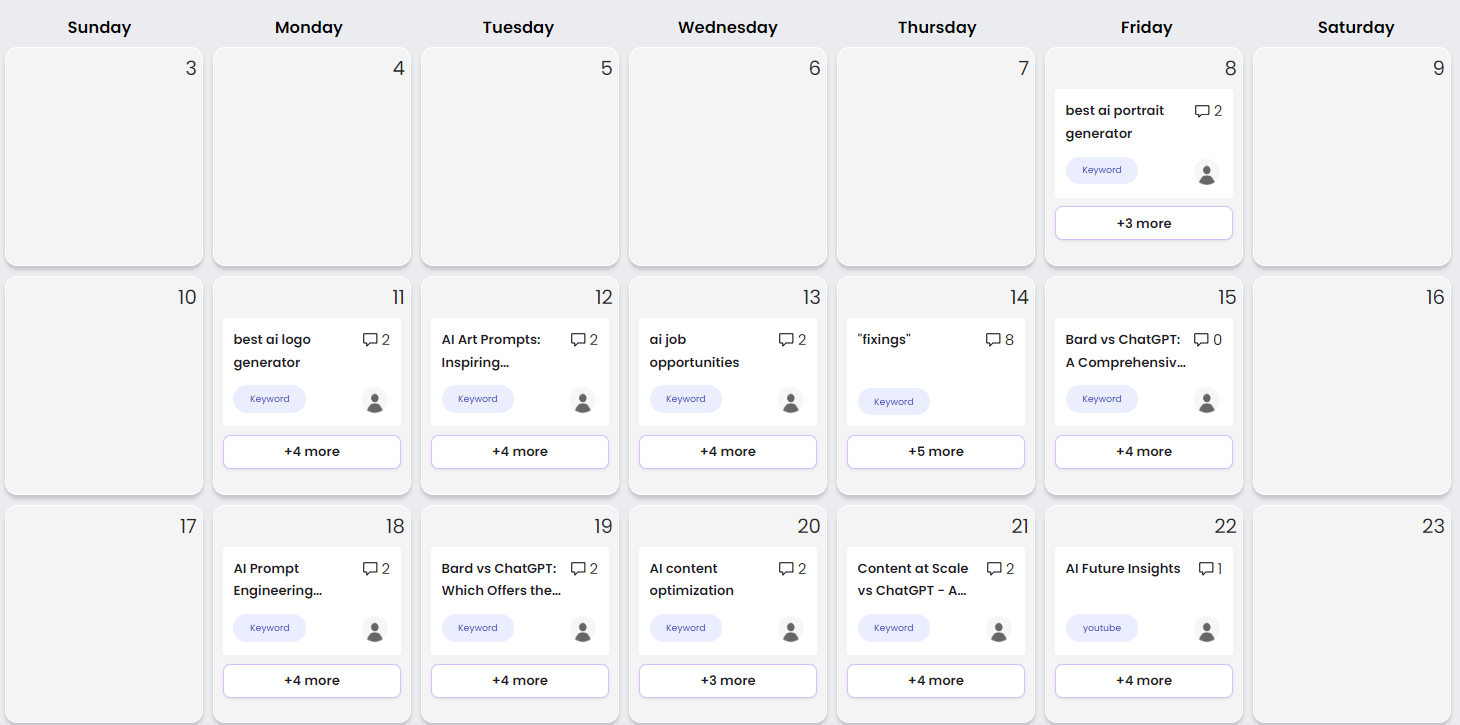
Step 6: Choose The Right Content Types and Formats
This next stage of building a powerful content marketing strategy is crucial to reach those people waiting to hear what you have to say.
While content itself reigns supreme, getting the format on point is key. Just like there are a lot of ways to learn new things, there are several compelling content types that will effectively serve your strategy.
Will it be written blog posts packed with helpful advice? Podcasts that your audience listens to while commuting to work? Or captivating videos full of visuals and cool effects?
These three are popular choices used in most effective content marketing strategies. However, deciding the best fit for your company depends on that research you did earlier, knowing where your target audience spends their time. This might include YouTube or TikTok for captivating videos or Medium, LinkedIn, and even Facebook for informative blog posts.
Statistics back up video’s popularity – nearly all companies already use video marketing as a marketing strategy. This strategy gets your point across in a dynamic way, allowing people to watch a few minutes of advice instead of reading through paragraphs of text.
But this doesn’t mean words are pointless – after all you’re reading a blog post, right? You know as well as I do, helpful written articles have an undeniable power to convey ideas.
But how do you know what format your audience likes? A tool like Buzzsumo helps you research any topic, analyze what’s been popular and gauge what kind of format your ideal customers enjoy reading and engaging with.
Step 7: Create High-Quality, Engaging, and Share-Worthy Content
Here comes the heart of content marketing – creating compelling pieces of writing. While researching and planning sets the stage for a successful content marketing strategy, if you have bad content, the effort is largely wasted. This stage is where you bring your content ideas to life.
This involves crafting compelling headlines, writing informative and engaging body copy, incorporating visuals such as images and videos, and optimizing your content for search engines and readability.
Perform Keyword Research
One critical point of success is making your content findable online. People search using a variety of keyword phrases, but how do you know what those phrases are?
Do your keyword research.
Let’s go back to the busy moms for a second. If your product is targeted toward them, some smart keywords to consider might be “best time management tips for moms”, “quick and healthy snacks for kids”, “productivity tips to reduce overwhelm”, or “finding time for self-care”.
The goal here is simple: find out which keywords are most relevant to your audience so that when they search for information online, your content shows up front and center.
Keyword research tools like Google Keyword Planner, Semrush, and Ahrefs can help you identify relevant keywords and search terms that align with user intent. Look for high-volume keywords with relatively low competition and long-tail keywords that are specific to your niche.
Tips for choosing target keywords:
- Select high-volume yet low-competition words.
- Aim at answering user intent.
- Consider both informational and transactional searches.
- Prioritize relevance over popularity.
BrandWell has an in-app keyword research tool that allows you to unearth golden phrases that you can turn into in-depth blog posts in just one click! No need to buy separate tools for finding keywords and writing content — saving you hundreds of dollars per year!
Here’s a screenshot of the BrandWell keyword research tool:
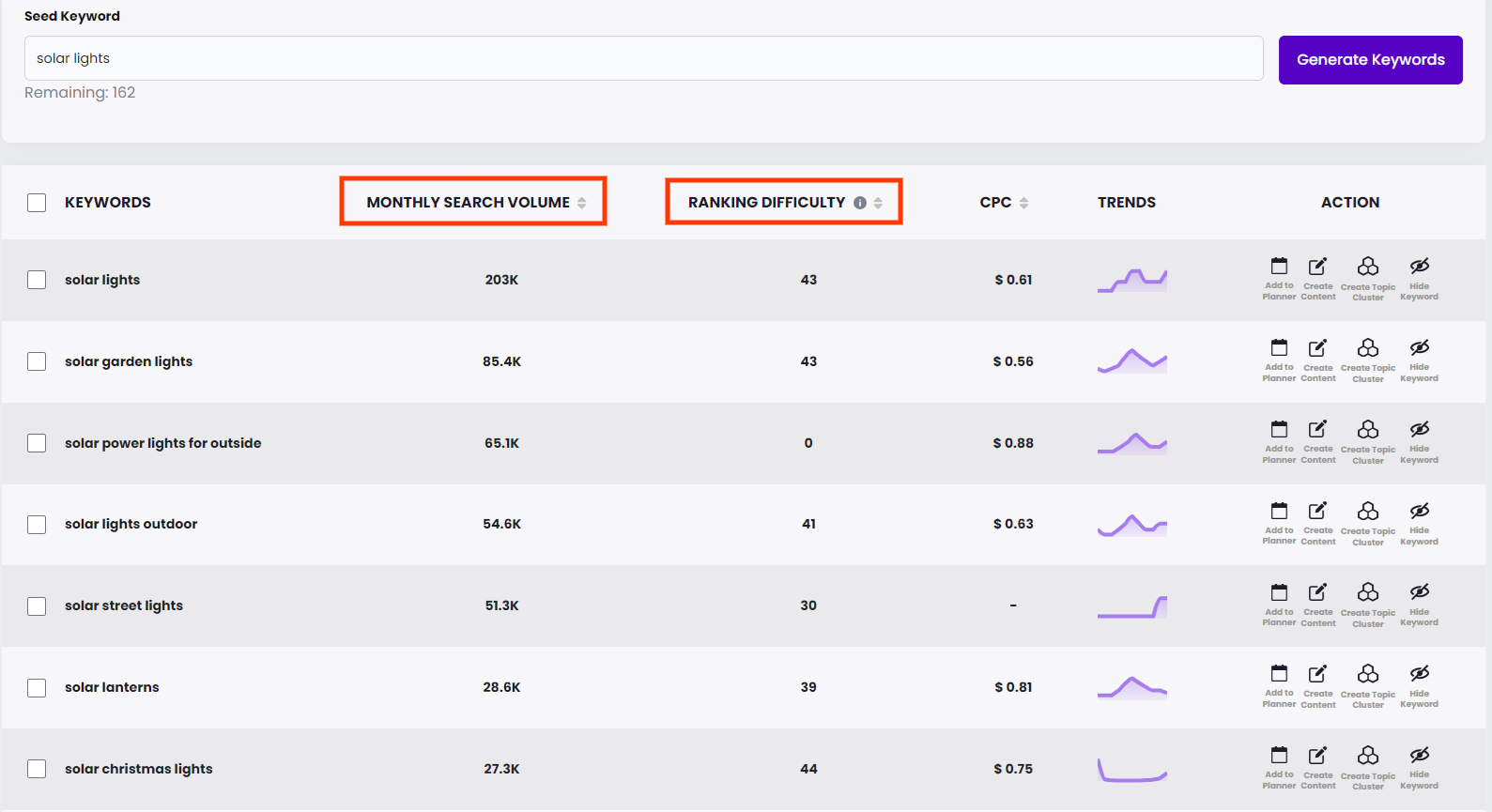
Data from a recent report by Ahrefs paints a grim picture: almost all newly published content doesn’t attract organic traffic through Google searches.
Don’t let that be the fate of your brilliant work. When incorporating keywords into content, try to avoid clunky, over-stuffed phrases crammed into every paragraph.
Instead, let those carefully selected keyword phrases appear in headings, titles, image file names, and article text – basically weaving them in naturally wherever they seem to make sense.
Here are some key elements to consider when creating high-quality content:
- Originality: Make sure your content is unique, valuable, and offers a fresh perspective to your audience.
- In-depth information: Provide comprehensive information on the topic at hand. This can include statistics, case studies, or expert opinions.
- User experience (UX): Make sure your website is easy to navigate with a clean design and clear headings. A positive user experience will keep visitors engaged with your site longer.
Remember: Google loves fresh and unique material. And for your content to climb up the SERP rankings, it must exhibit Experience, Expertise, Authoritativeness, and Trustworthiness — 4 key elements in Google’s criteria for ranking content. Write your content from the perspective of an expert in your industry.
Diversify Your Content
When it comes to catching and keeping your audience’s attention, variety isn’t just the spice of life—it’s essential. Switching up your content collection entails not merely changing subjects but also utilizing assorted types and styles of content to captivate different slices of your audience in a meaningful way.
Blog Posts
Evergreen blog posts are a cornerstone for any content marketing strategy because they provide steady organic traffic long after their publication date. These pieces remain relevant over time, continually drawing in new readers with valuable insights.
The beauty of blog posts lies in their versatility — from deep dives into industry trends to how-to guides or listicles, there’s no limit to the subjects you can cover. This flexibility allows you to address multiple facets of your target market’s interests and needs.
The core of BrandWell is long-form blog generation. Marketers and entrepreneurs love it for its ability to create content at scale — all it takes is one keyword to publish a 2,000-word blog post (we’ve seen it write up to 12,000 words!) that ranks well in Google.
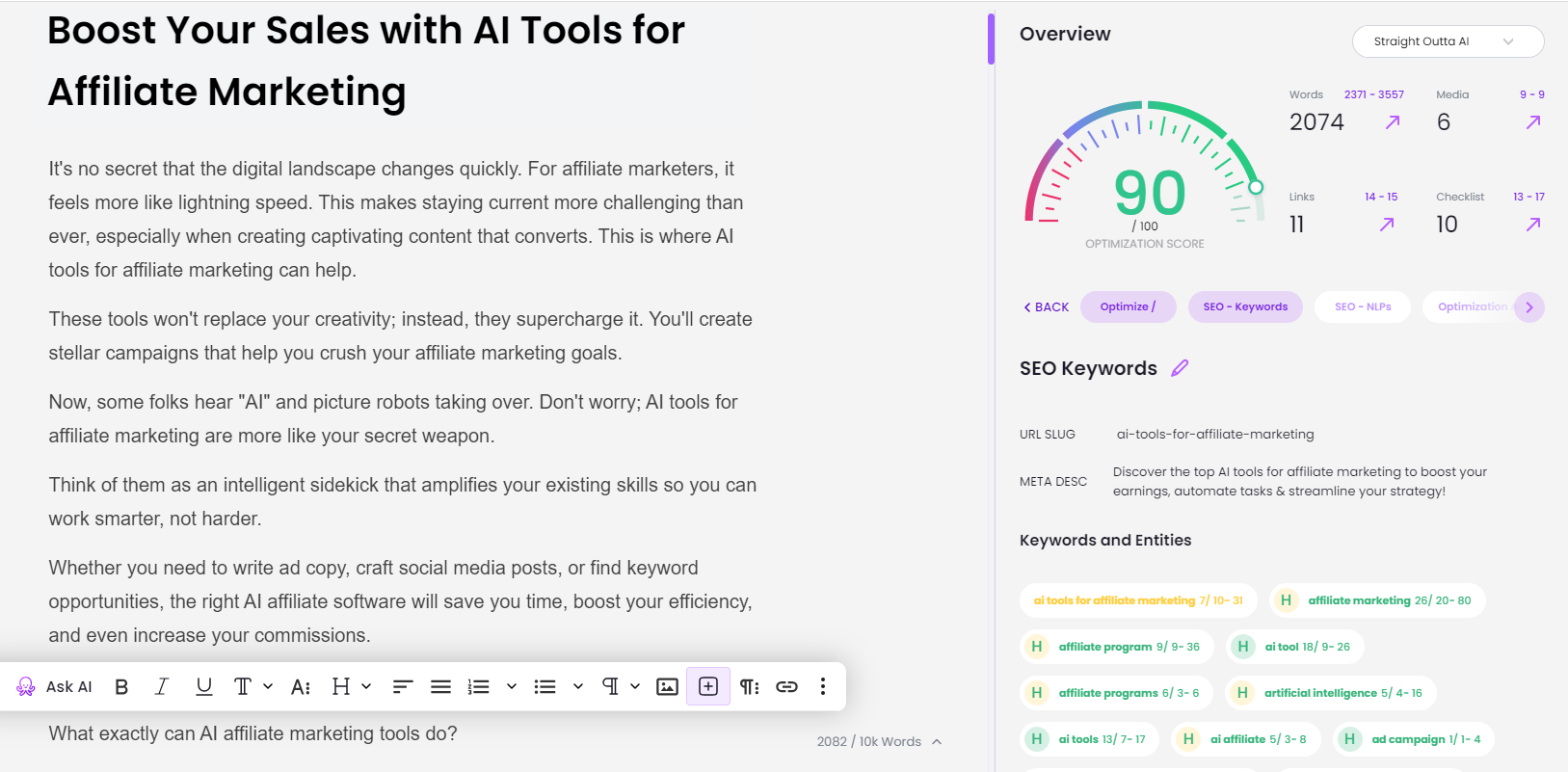
Infographics
In today’s digital age where information overload is a common challenge, infographics have emerged as a powerful tool to capture the attention of your target audience. These visually engaging pieces can significantly enhance your content creation efforts by making complex data easily understandable at a glance.
Why do infographics work so well? The answer lies in their ability to combine text, images, and design to tell a compelling story that resonates with viewers. Studies show that humans can process visual information 60,000 times faster than text. This means infographics are not only more likely to be viewed but also remembered longer than traditional textual content. For marketers aiming for both reach and impact, understanding the science behind infographic effectiveness is crucial.
The first step in any successful content marketing strategy involves building robust brand awareness. Social media platforms, with their billions of active users, present an unparalleled opportunity for brands to connect with potential customers globally.
By crafting engaging, relevant content tailored to the interests and needs of your target audience, you can significantly increase your brand’s visibility. A strategic approach includes creating visually captivating posts that speak directly to your audience, participating in trending conversations, and employing hashtags.
A critical aspect often overlooked by marketers is the power of social media to drive substantial traffic back to their website or blog. Each post shared on platforms like Twitter, Facebook, or LinkedIn acts as a beacon guiding users to more detailed information housed on your main site. This not only improves SEO rankings through increased engagement but also enhances user experience by providing them with easy access to valuable resources.
User-generated content (UGC) has emerged as a goldmine for enhancing authenticity and trust among audiences. Encouraging satisfied customers or followers to share their experiences or reviews about using your products/services effectively turns them into brand ambassadors — amplifying positive sentiment across various channels without significant investment from you. Platforms such as Instagram excel at showcasing UGC through features like stories and tags, thus providing businesses an avenue to spotlight real-life applications of their offerings.
Videos
Video content is hot right now. Videos are a captivating medium, unparalleled in their ability to draw and maintain viewer attention. They offer dynamic ways to present information — whether through tutorials, behind-the-scenes looks at your business processes, or customer testimonials — that resonate on a personal level with viewers.
If you ran a content audit and have identified your best performing pieces of content, consider converting them into other effective formats. A popular blog post could evolve into a series of YouTube videos or an infographic summarizing key points for visual learners.
Turning your content into different formats is like squeezing every last drop of goodness out of a winning strategy. You get to connect with more folks on their favorite platforms, all while keeping your brand top of mind with awesome content across the board.
Got a top-ranking blog post that’s about to go stale? Perhaps a popular YouTube video you want to turn into long-form content? You can use BrandWell to repurpose these pieces into fresh, 100% original content by simply entering their URL.
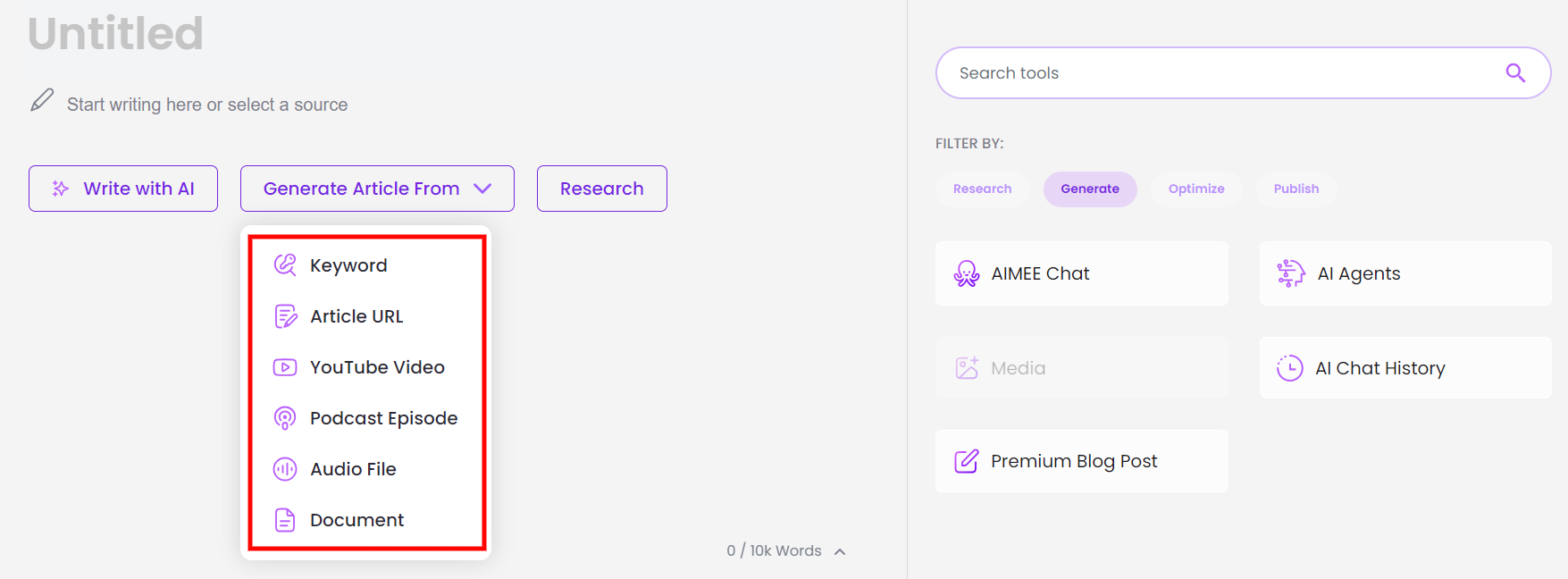
Diversifying your content portfolio ensures that each piece serves a specific purpose within your overall marketing strategy — tailored precisely for distinct segments of your audience.
Engagement and Conversions
Don’t get fixated on Google only. Incorporating engagement techniques helps connect more effectively with customers on any platform you choose. People spend time online to learn about interesting ideas, see videos with useful steps, be entertained, and connect with those they share common ground with – not be bogged down with boring, technical terms.
Instead of delivering long blocks of unbroken text that cause their eyes to glaze over, add images, headers, and bullet points to visually divide long articles. Colorful infographics are also great for catching their attention.
Videos also hold immense potential for boosting your engagement rate and nearly nine out of ten businesses can confirm its efficacy. This strategy fits your marketing plan by making information easier to absorb for busy people short on time – even short-form content on social platforms uses videos as the main draw.
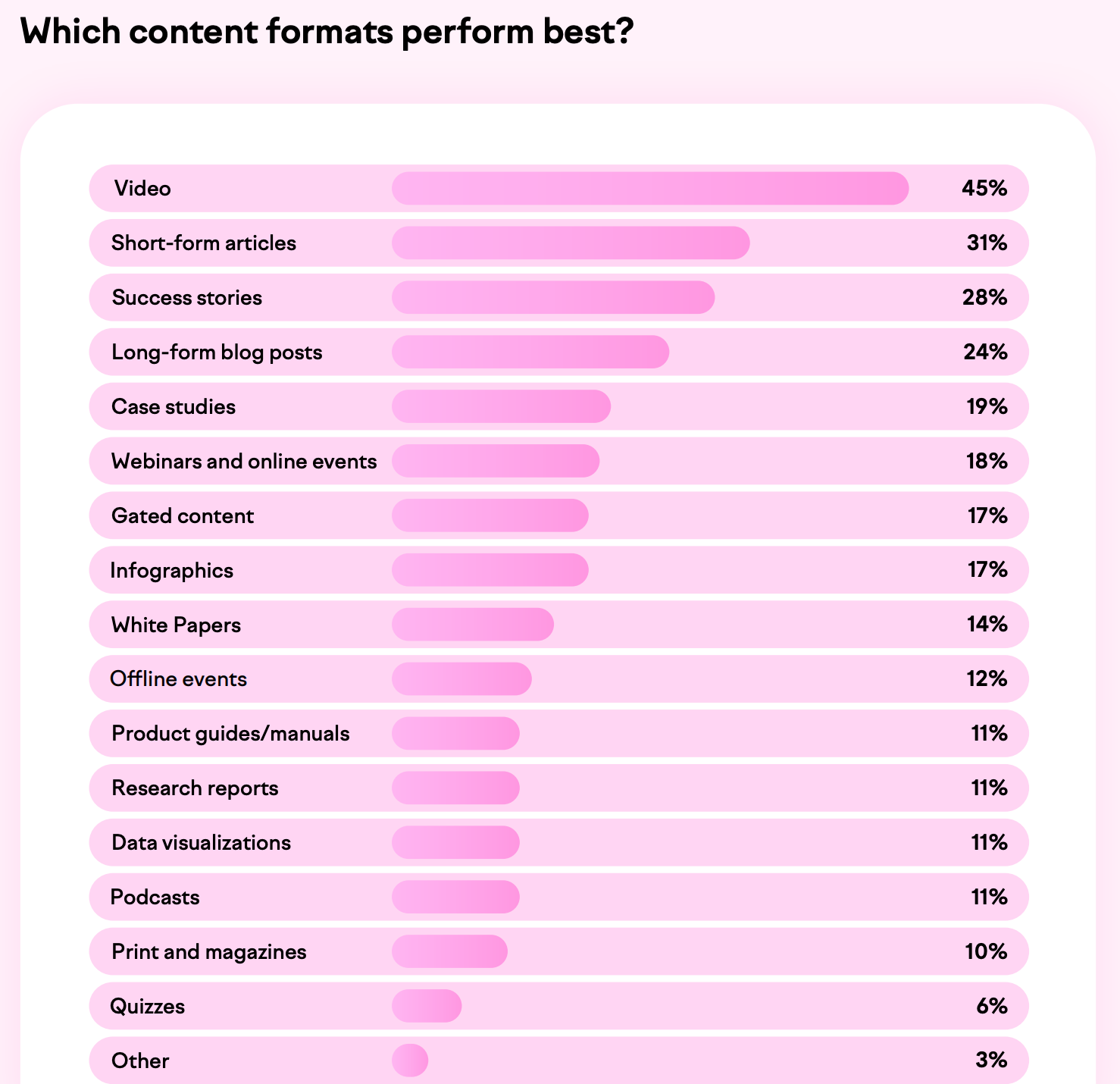
Best types of content according to a Semrush survey
Consider your business objective; this will guide what type of ‘call to action’ to add to your marketing plan. Do you aim to boost email subscribers so that you can stay connected via a regular newsletter? Would you like your audience to contact you directly so that you can discuss the specific solutions you can provide?
Make it easy to reach the objective. Adding clickable buttons that encourage people to sign up to your mailing list, sharing your contact information in an easily visible location, creating landing pages tailored to specific products, and offering ‘click to call’ options for those wanting immediate contact can all help a good content marketing strategy really flourish.
Content creation is where BrandWell truly shines. This brand growth engine can automate your entire process — whether you’re writing long-form blog articles, social media posts, email sequences, product descriptions, ad copy, or video scripts.
Step 8: Promote Your Content
Another mistake new entrepreneurs, independent sales representatives, retail store chains, and even larger businesses often make is forgetting that high-quality content, once it’s finished, doesn’t automatically attract an audience.
Content promotion should be integrated into any sound marketing strategy plan. Don’t just hit “publish” and hope for the best. Actively promote your content through various channels to reach a wider audience.
Here are some effective ways to promote your content across multiple channels:
- Social media: Share your content on popular social media platforms like Facebook, Twitter, Instagram, and LinkedIn. Tailor your posts according to each platform’s unique features and user demographic.
- Email marketing: Send out newsletters or promotional emails with links to your latest content. Make sure you have an engaging subject line that encourages recipients to open the email.
- Influencer outreach: Collaborate with influencers in your industry who can share or endorse your content, helping it reach a wider audience. Research relevant influencers using tools like BuzzSumo Influencer Search.
- Guest blogging: Contribute guest articles to reputable websites within your niche, including backlinks to related pieces of content from your site. This not only drives traffic but also improves your domain authority.
- Paid advertising: Invest in paid advertising options such as Google Ads or sponsored social media posts to increase the exposure of your key content pieces.


Source: HubSpot
One of the best ways to promote your content is through paid advertising. Paid ads are kind of like setting a fast travel point on a map – quickly zipping to that next destination by using targeted social media promotions to capture interest as potential customers scroll through those daily news feeds.
Take for example Revolve, a fashion company that expertly combines paid ads with user-generated content on platforms like Facebook to expand reach, making sure customers get introduced to their diverse fashion lineup as they flip through their feed. This approach delivers those compelling fashion visuals directly into potential customer newsfeeds.
But there’s more. Podcast marketing opens up other options. A large number of listeners will regularly engage, with current numbers showing nearly 70 million Americans already tune in. That’s a lot of ears, giving brands the unique potential to share their insights in an audio format that their customers choose to listen to.
Think of this: what’s one of the top ways you connect with friends? Sharing information. This aspect of communication doesn’t disappear just because your intent is marketing. Implementing these distribution and promotion strategies as a marketing strategy helps connect you directly to these digital tribes ready to welcome your content.
Step 9: Evaluate Performance Metrics
While all the previous steps establish the foundation for any solid content marketing strategy plan, keeping those eyes on those chosen performance metrics reveals what is working – and where those small adjustments might be needed.
Consider it an ongoing feedback loop; one that signals potential adjustments, course correction, and fresh insights.
Regularly monitor your content’s performance using tools like Google Analytics and Google Search Console. Track important metrics such as organic traffic, keyword rankings, backlinks, and conversions. Analyze the data to identify areas for improvement and make data-driven decisions.
- Traffic: Monitor website visits from various sources like organic search results or referrals from other sites.
- Bounce rate: Keep track of users who leave after viewing only one page on your site – this could indicate low-quality content or poor user experience.
- Conversion rates: Measure how effectively your content leads visitors towards desired actions such as signing up for newsletters or making purchases.
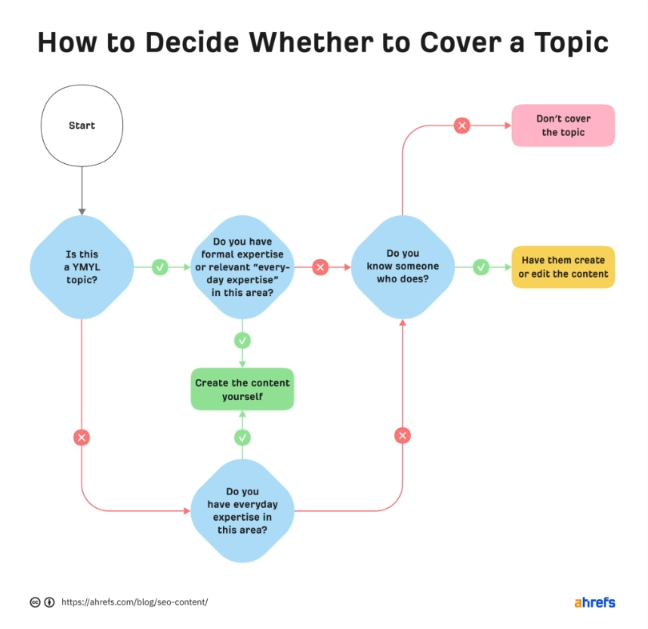

A flowchart from Ahrefs on how to choose a content topic
Examples of Successful Content Marketing Campaigns
Diving right into the heart of successful content marketing, let’s look at some campaigns that knocked it out of the park.
Social Media Content Marketing
Social media stands as a powerful platform for engaging with audiences and driving brand awareness. Brands that master the art of storytelling and engagement in these spaces often see remarkable success in their campaigns.
Wendy’s and Oreo stand out as prime content marketing examples of creative social media marketing.
Engaging Audiences with Wit: The Wendy’s Twitter Saga
The Twitter account of Wendy’s is known for its sharp wit and humorous banter. This fast food chain has effectively used social media to craft a unique brand voice that not only entertains but also engages followers in real-time conversations.
By roasting competitors and playfully interacting with customers, Wendy’s demonstrates how brands can use humor to remain top-of-mind among consumers.
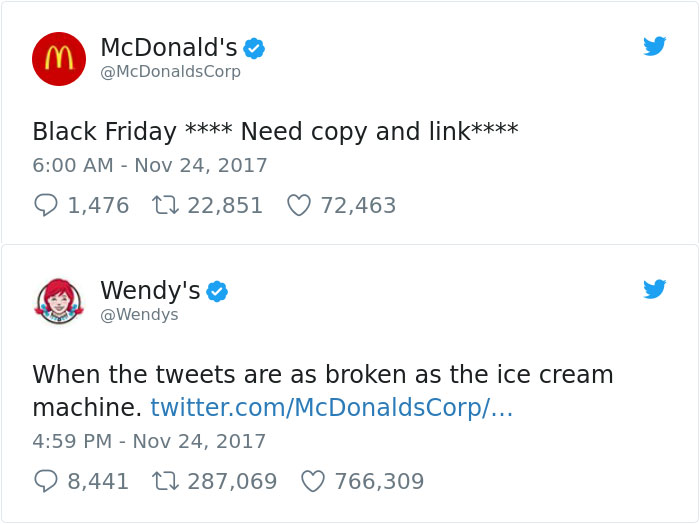

Oreo’s Creative Twist on Daily Events
Similarly, Oreo took content marketing by storm with its Daily Twist campaign. For 100 days, they captivated audiences by integrating Oreos into trending topics across social media. This clever approach not only showcased the brand’s creativity but also highlighted how companies can leverage current events to foster community engagement and enhance shareability online.
The campaign was so good that it even won a Clio award in 2013.


Key takeaways:
- Creativity: Both examples underscore the importance of creative thinking in content marketing strategies.
- Audience Engagement: Engaging directly with your audience fosters a sense of community around your brand.
- Hop on Trends: Incorporating current trends or popular culture references makes your content more relatable and engaging for users.
The successes achieved by Wendy’s witty interactions or Oreo’s innovative daily posts serve as compelling case studies for any business looking to elevate its presence on social media. They illustrate that when done right, engaging in platforms like Twitter or Instagram doesn’t just sell products — it builds lasting relationships with an ever-growing audience base eager for what you’ll post next.
Video Content Marketing
Video content marketing is hot right now and it’s showing no signs of slowing down. Consumers are increasingly turning to video content for information, entertainment, and education because videos are engaging, easy to consume, and often more memorable than text-based content.
Social media platforms like YouTube, Instagram, TikTok, and Facebook heavily prioritize video content in their algorithms. This means that video content often reaches a larger audience and generates more engagement than other types of content.
Let’s look at three content marketing examples of excellent video content marketing.
The GoPro Phenomenon
By harnessing the power of stories told by its users, GoPro transformed into a symbol of exploration and thrill. They encouraged users to share their own adrenaline-pumping videos taken with GoPro cameras. This approach not only showcased the product’s durability and quality but also built a community around shared experiences.
This strategy transformed customers into brand ambassadors, driving sales without traditional advertising.


Airbnb’s “Live There” Campaign
Airbnb shifted focus from places to stay to living like a local with its “Live There” campaign. Airbnb showcased genuine tales from hosts, revealing unique dwellings and adventures across the globe, thus fulfilling the quest for authenticity.
This narrative-driven approach helped differentiate Airbnb in a crowded market, emphasizing personal connections over transactions.


Dove’s Real Beauty Sketches
Dove’s “Real Beauty Sketches” blitz on social media provocatively questioned the norms of beauty society holds dear. The compelling video series featured forensic artists drawing women as they see themselves versus how others see them.
This powerful message resonated globally; proving content that sparks conversation can dramatically increase brand visibility and impact.
This campaign also won a Clio in 2014.


Email Marketing
Successful content marketing campaigns are not just limited to ads. Email marketing still holds a pivotal role in fostering customer engagement and driving sales. Companies like Warby Parker and Airbnb have set benchmarks with their innovative email strategies, demonstrating how personalized and targeted communication can enhance the consumer experience.
Let’s look at why Warby Parker and Airbnb are perfect content marketing examples of a successful email campaign.
Warby Parker: A Masterclass in Email Engagement
Warby Parker has redefined the e-commerce landscape through its exceptional use of email marketing campaigns. By leveraging this channel, they’ve managed to not only boost their online presence but also solidify their brand identity.
Their strategy revolves around engaging customers with timely updates, product launches, and interactive content that encourages direct interaction. This approach ensures that consumers remain connected with the brand beyond just transactional exchanges.


Airbnb’s Personalized Travel Guides
In a similar vein, Airbnb utilizes email marketing to deliver value-added services directly to its users’ inboxes. Through meticulously crafted emails containing personalized travel guides based on previous searches and bookings, Airbnb enhances user experiences by offering relevant local insights and unique adventure suggestions.
This level of personalization not only fosters loyalty but also drives repeat business by making each communication feel tailor-made for the recipient.
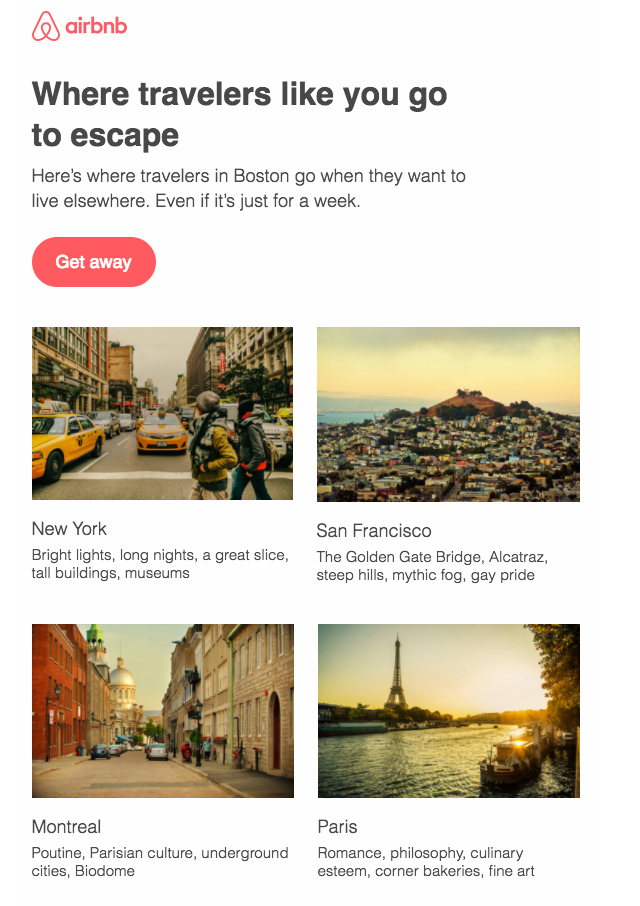

Key Takeaways:
- User-Centric Approach: Both companies exemplify how understanding your audience’s needs leads to more effective engagements.
- Creative Content Delivery: Leveraging emails as a platform for creative storytelling strengthens brand connections.
- Data-Driven Personalization: Utilizing consumer data to craft personalized messages increases relevance and response rates.
The success stories of Warby Parker and Airbnb underscore the importance of integrating creativity with technology in email marketing strategies. These examples serve as inspiration for businesses aiming to elevate their digital communications game by focusing on providing superior customer experiences.
B2B Content Marketing
Exploring successful B2B content marketing examples offers invaluable insights for marketers aiming to refine their strategies in the competitive digital landscape. Two standout content marketing examples, HubSpot and The B2B Marketing Podcast, illustrate how content can effectively position a brand as an industry thought leader while providing actionable value to its audience.
The B2B Marketing Podcast: Engaging Through Expert Insights
The power of podcasts in content marketing cannot be overstated, especially when it comes to engaging a professional audience with deep-dive discussions on industry trends and challenges.
The B2B Marketing Podcast excels by inviting experts across various sectors, offering listeners not only theoretical knowledge but practical takeaways that can be implemented immediately. This approach not only enriches the listener’s understanding but fosters a sense of trust and reliability towards the podcast creators.
Enhancing user experience by incorporating expert images could further personalize this connection, making each episode visually appealing and recognizable at first glance.
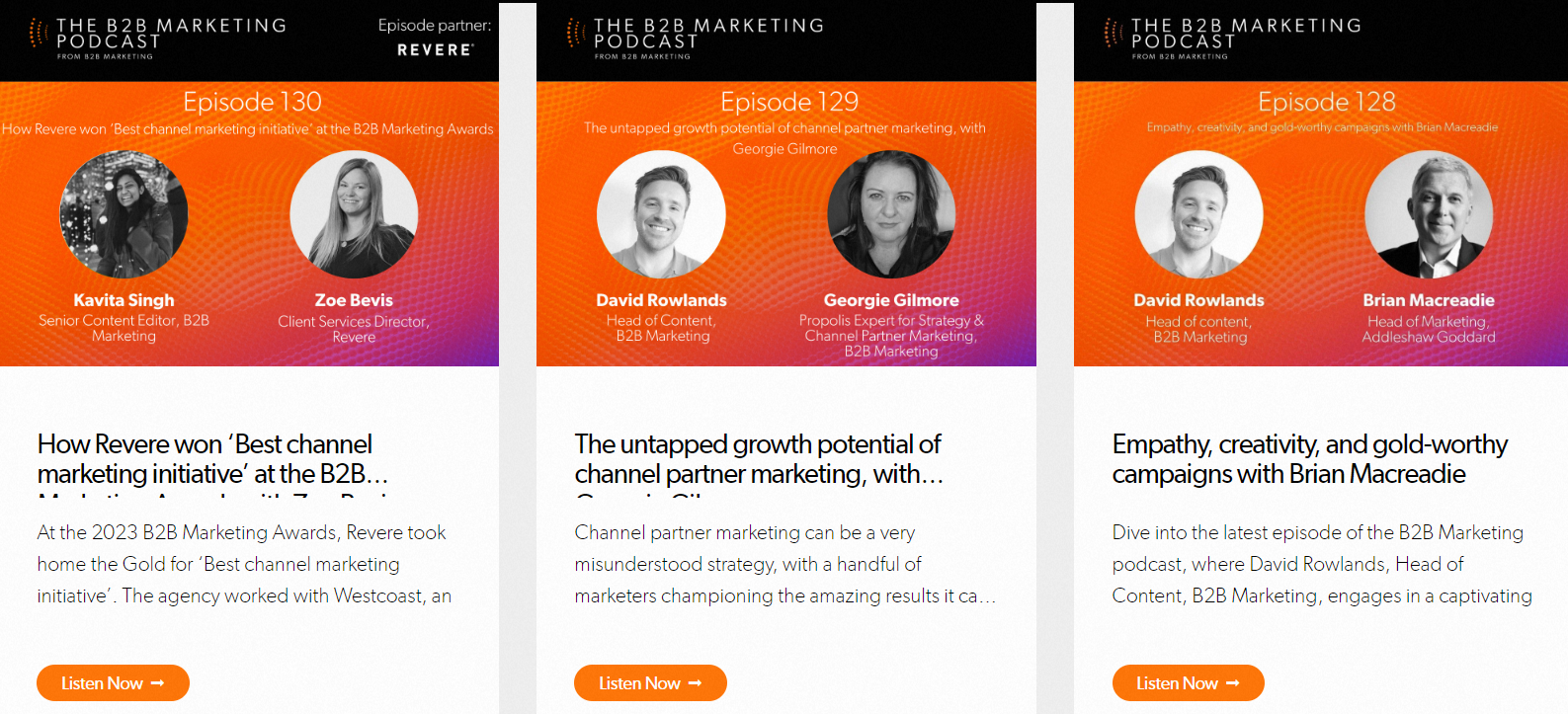

HubSpot’s Inbound Marketing Success
HubSpot mastered the art of inbound marketing by providing valuable resources like blogs, guides, templates, and tools for free. Their comprehensive resource library has become a go-to for marketers looking to learn new skills or brush up on trends. You’ll find an abundance of resources at HubSpot Resources.
This educational approach established HubSpot as an authority in digital marketing while subtly promoting its software solutions through practical application.
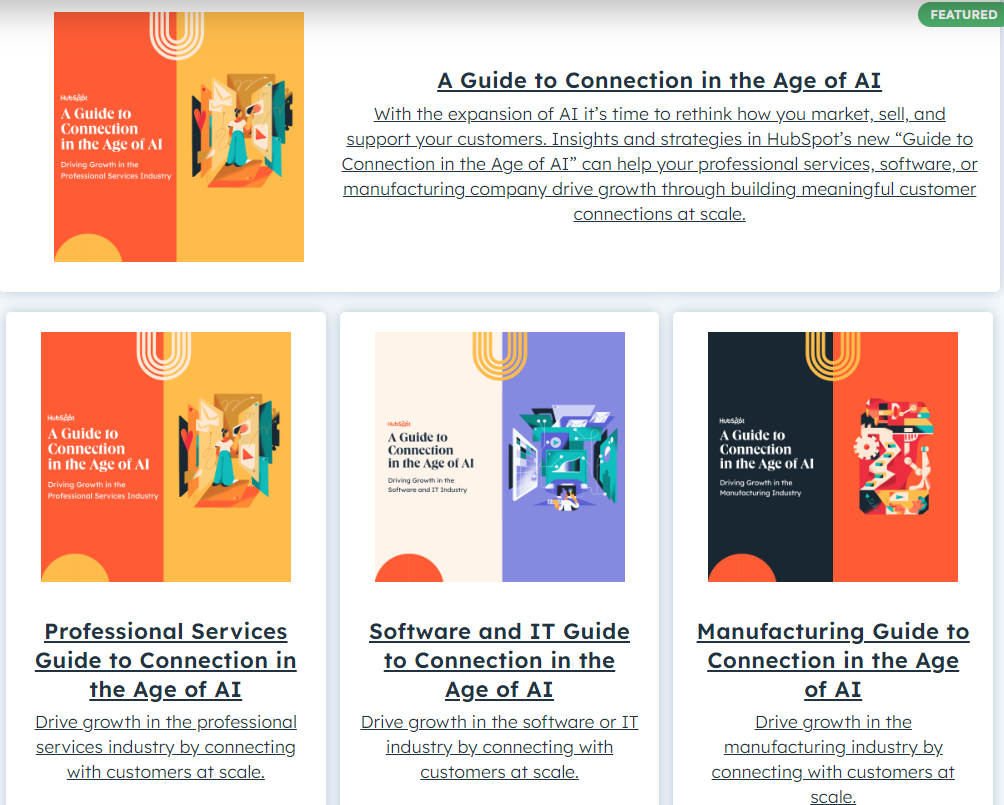

Focusing on delivering high-quality content tailored specifically toward its intended audience has enabled both these companies to not merely survive but thrive within their niches. By addressing real-world problems with actionable solutions while maintaining consistent engagement levels across platforms – whether auditory or textual – they set benchmarks for what effective B2B content marketing looks like.
These examples show us there is no one-size-fits-all solution in content marketing — success comes from knowing your audience deeply and crafting messages that resonate on a human level.
Challenges and Solutions in Content Marketing
Content marketing comes with its own set of challenges, but there are effective solutions to address them.
Here’s a breakdown:
Creating Quality Content: One of the biggest challenges is consistently producing high-quality content that resonates with your target audience.
Solution: Invest time in understanding your audience’s needs and preferences through research and analytics. Create a content calendar to maintain consistency and plan content topics in advance.
Meeting Demand: Creating fresh content regularly can be time-consuming and expensive.
Solution: Repurpose existing content into different formats and channels to extend its lifespan and reach new audiences. For example, you can turn blog posts into videos, podcasts, or ebooks, or break down long-form content into shorter, digestible formats for social media.
BrandWell can help you repurpose YouTube videos, podcast episodes, and even existing blog posts into 100% original, SEO-optimized long-form articles — in just one click.
Generating Engagement: Getting your audience to engage with your content can be difficult in a saturated online environment.
Solution: Encourage interaction by asking questions, running polls, and responding to comments promptly. Utilize multimedia content such as videos, infographics, and interactive tools to make your content more engaging.
Content Distribution: Even the best content won’t deliver results if it doesn’t reach the right audience.
Solution: Develop a comprehensive content distribution strategy that leverages multiple channels, including social media, email marketing, SEO, and influencer partnerships. Tailor your content for each platform and audience segment to maximize reach and engagement.
Measuring ROI: Determining the return on investment (ROI) of content marketing efforts can be challenging, especially when it comes to attributing revenue directly to content.
Solution: Set clear goals and key performance indicators (KPIs) for your content marketing campaigns, such as website traffic, lead generation, or brand awareness. Use analytics tools to track and analyze metrics to evaluate the effectiveness of your content.
Staying Relevant: Trends and consumer preferences are constantly evolving, making it challenging to keep up with the latest developments.
Solution: Stay informed about industry trends and changes in consumer behavior through market research, competitor analysis, and ongoing monitoring of social media and online communities. Adapt your content strategy accordingly to remain relevant and meet the evolving needs of your audience.
By addressing these challenges with strategic solutions, businesses can overcome barriers and unlock the full potential of content marketing to drive engagement, build brand awareness, and drive conversions.
Future Trends in Content Marketing
In the ever-shifting landscape of content marketing, remaining at the forefront requires vigilant observation of upcoming trends.
Let’s dive into what lies ahead for content marketing in the era of AI.
Personalization at Scale
Gone are the days when one-size-fits-all content could cut it. Today, personalization is not just preferred; it’s expected.
Artificial intelligence can help marketers tailor content to individual preferences, behaviors, and historical interactions. Adopting a hyper-personalized strategy significantly enhances user involvement by addressing the unique desires and inclinations of each individual.
But there’s a catch — balancing personal touch with privacy concerns can be tricky. Diving deeper into this trend, it’s vital to openly communicate how you are using your clients’ data to preserve the bond of trust.
AI-Driven Content Creation
The rise of artificial intelligence in content creation sparks both excitement and debate. On one hand, AI tools offer efficiency gains by automating research and drafting processes, allowing creators to focus more on strategy and less on grunt work.
However, while AI can generate articles quickly, it lacks the nuance of human emotion. For now, blending AI-generated drafts with human editing seems to be the sweet spot — combining speed with soul.
Here’s a more in-depth guide on the pros and cons of AI-generated content vs. human-written content.
Interactive Media Takes Center Stage
Interactive media, including quizzes, polls, and augmented reality adventures, are increasingly capturing our attention. These formats invite audience participation, making them more engaging than passive consumption.
However, this also means brands need to get creative. Not every attempt at interactivity hits its mark, but when done right, it can significantly boost user engagement levels.
Embracing these trends requires flexibility, a willingness to experiment, and most importantly, a focus on delivering genuine value. For those in the content marketing field, this is a thrilling era filled with opportunities for innovation and adaptation.
FAQs – How to Create a Content Marketing Strategy
What is a content strategy in SEO?
Content strategy for SEO refers to the planning, development, and management of written and visual content to improve a website’s search engine rankings. It involves keyword research, audience analysis, and creating high-quality, relevant content that appeals to both users and search engines.
Does content strategy help SEO?
Yes, a well-executed content strategy significantly helps improve SEO. By producing valuable and engaging content tailored for your target audience while incorporating targeted keywords naturally within the text, you can boost organic traffic from search engines as well as increase user engagement on your site.
How do you write an SEO content strategy?
To write an effective SEO content strategy:
- Conduct thorough keyword research.
- Analyze your target audience’s needs and preferences.
- Create high-quality original content that addresses those needs.
- Optimize titles/meta descriptions/alt tags for better visibility.
- Implement internal and external linking strategies.
- Regularly update existing material.
What is the difference between a content strategy and an SEO strategy?
A content strategy focuses on planning, creating, and managing all forms of digital media (written, visual, and audio), whereas an SEO strategy specifically targets increasing online visibility through higher SERP rankings.
However, both strategies often overlap as high-quality content is a crucial component of effective SEO practices.
How can I improve my SEO and content marketing?
Improve your SEO and content marketing by focusing on creating valuable and informative pieces that resonate with your target audience. Conduct keyword research to find opportunities for ranking improvement. Optimize existing articles using proper header tags, internal linking strategies, image optimization (alt text), and mobile-friendliness improvements.
How to use SEO as a marketing strategy?
Using SEO as a marketing strategy involves optimizing website structure (technical) along with producing high-quality, targeted content based on keyword research. Monitor rankings regularly to measure success while continuously refining site performance and user experience. Additionally, build authority via backlinks from reputable sources to increase organic traffic.
Conclusion
A content marketing strategy is crucial for businesses looking to improve their online presence and attract more customers. By following these steps, you can create a successful content strategy that will help you reach your target audience and accomplish your business objectives.
- Identify your target audience: Understanding who your ideal customer is will help you create content that resonates with them.
- Research keywords: Conducting keyword research will ensure that your content is optimized for the right search terms.
- Create quality content: Producing high-quality, engaging content will keep visitors on your site longer and increase the chances of them converting into customers.
- Optimize content for SEO: Incorporating keywords, meta descriptions, and other on-page optimization techniques will make it easier for search engines to crawl and index your pages.
- Promote your content: Sharing your content on social media platforms, email newsletters, or through outreach campaigns can expand its reach beyond just organic traffic from search engines.
Crafting an effective content marketing strategy is all about finding the perfect balance between creating valuable content and optimizing it for search engines. By understanding your target audience, conducting thorough keyword research, and crafting high-quality content, you can improve your website’s visibility, attract organic traffic, and boost your online presence.
BrandWell can help you automate your entire content marketing strategy so you can publish more while spending less. Sign up today!

UNLOCK YOUR POTENTIAL
Long Headline that highlights Value Proposition of Lead Magnet
Grab a front row seat to our video masterclasses, interviews, case studies, tutorials, and guides.

